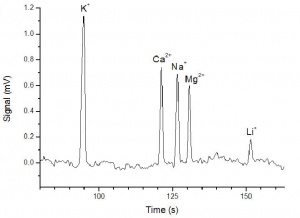Difference between revisions of "C4Dキャピラリー電気泳動を用いた無機陽イオン検出"
| Line 6: | Line 6: | ||
スイスのバーゼル大学では自前のキャピラリー電気泳動The (CE) 装置に eDAQ C4D システムを組み込み、K<sup>+</sup>, Ca<sup>2+</sup>, Na<sup>+</sup>, Mg<sup>2+</sup> 及び Li<sup>+</sup> 等の陽イオンを分析しています。測定条件は以前に報告された方法と似ています: Comparison of Different Contactless Conductivity Detectors for the Determination of Small Inorganic Ions by Capillary Electrophoresis; Pavel Kubáñ, Christopher J. Evenhuis, Mirek Macka, Paul R. Haddad, Peter C. Hauser; Electroanalysis 18, 2006, No. 13-14, 1289 – 1296 | スイスのバーゼル大学では自前のキャピラリー電気泳動The (CE) 装置に eDAQ C4D システムを組み込み、K<sup>+</sup>, Ca<sup>2+</sup>, Na<sup>+</sup>, Mg<sup>2+</sup> 及び Li<sup>+</sup> 等の陽イオンを分析しています。測定条件は以前に報告された方法と似ています: Comparison of Different Contactless Conductivity Detectors for the Determination of Small Inorganic Ions by Capillary Electrophoresis; Pavel Kubáñ, Christopher J. Evenhuis, Mirek Macka, Paul R. Haddad, Peter C. Hauser; Electroanalysis 18, 2006, No. 13-14, 1289 – 1296 | ||
| − | == | + | == '''引用''' == |
| − | * | + | * サンプル: 10 µM のカリウム、カルシウム、ナトリウム、マグネシウム、リチウムの水溶液 |
| − | * | + | * バッファー: ヒスチジン 12 mM と 酢酸 50 mM |
| − | * | + | * 測定条件: |
| − | ** | + | ** 分離電圧 = 30 kV |
| − | ** | + | ** 分画電流 = 11 ~ 12 µA |
| − | * | + | * キャピラリー: |
| − | ** | + | ** Polymicro Technologies 社のフューズトシリカ |
| − | ** | + | ** 外径 = 360 µm |
| − | ** | + | ** 内径 = 50 µm |
| − | ** | + | ** 長さ = 60 cm |
| − | ** | + | ** 検出器までの長さ = 50 cm |
| − | * | + | * インジェクション: サイフォン原理、10 cm の高さで 15 秒間 |
* C4D settings | * C4D settings | ||
** frequency = 800 kHz | ** frequency = 800 kHz | ||
Revision as of 12:36, 21 February 2014
eDAQ C4D システムはキャピラリー電気泳動によるカリウム、カルシウム、ナトリウム、マグネシウム、リチウムなどの無機陽イオンの検出に使われています。
はじめに
スイスのバーゼル大学では自前のキャピラリー電気泳動The (CE) 装置に eDAQ C4D システムを組み込み、K+, Ca2+, Na+, Mg2+ 及び Li+ 等の陽イオンを分析しています。測定条件は以前に報告された方法と似ています: Comparison of Different Contactless Conductivity Detectors for the Determination of Small Inorganic Ions by Capillary Electrophoresis; Pavel Kubáñ, Christopher J. Evenhuis, Mirek Macka, Paul R. Haddad, Peter C. Hauser; Electroanalysis 18, 2006, No. 13-14, 1289 – 1296
引用
- サンプル: 10 µM のカリウム、カルシウム、ナトリウム、マグネシウム、リチウムの水溶液
- バッファー: ヒスチジン 12 mM と 酢酸 50 mM
- 測定条件:
- 分離電圧 = 30 kV
- 分画電流 = 11 ~ 12 µA
- キャピラリー:
- Polymicro Technologies 社のフューズトシリカ
- 外径 = 360 µm
- 内径 = 50 µm
- 長さ = 60 cm
- 検出器までの長さ = 50 cm
- インジェクション: サイフォン原理、10 cm の高さで 15 秒間
- C4D settings
- frequency = 800 kHz
- amplitude = 80 A
- headstage gain OFF
- Data recording:
- lowpass filter = 2 Hz
- range = 10 mV
- sampling rate = 1000 data points per second
Data and Limit of Detection
The figure shows the electropherogram for the 10 µM sample of inorganic cations. From this electropherogram, it can be estimated that the limit of quantitation (LOQ) of potassium, calcium, sodium and magnesium is 1 µM, and that of lithium is 3 µM. The limit of detection (LOD) is thus 0.3 µM for potassium, calcium, sodium and magnesium, and 1 µM for lithium.
